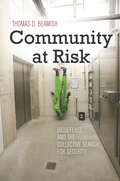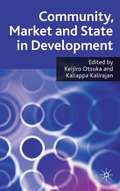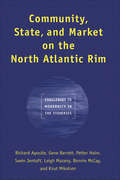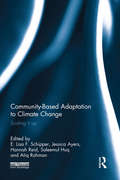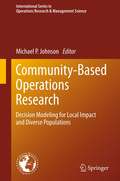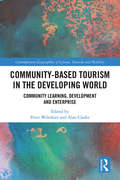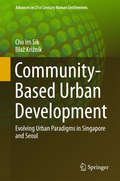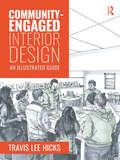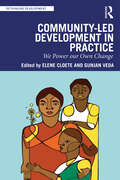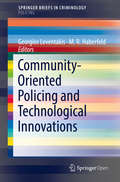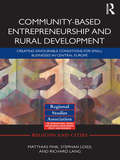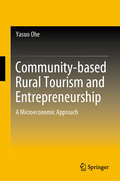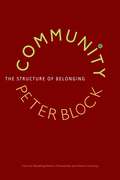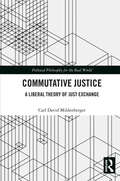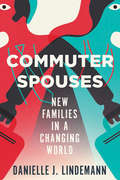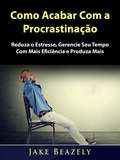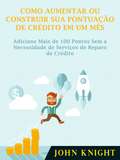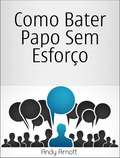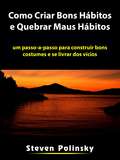- Table View
- List View
Community at Risk: Biodefense and the Collective Search for Security
by Thomas D. BeamishIn 2001, following the events of September 11 and the Anthrax attacks, the United States government began an aggressive campaign to secure the nation against biological catastrophe. Its agenda included building National Biocontainment Laboratories (NBLs), secure facilities intended for research on biodefense applications, at participating universities around the country. In Community at Risk, Thomas D. Beamish examines the civic response to local universities' plans to develop NBLs in three communities: Roxbury, MA; Davis, CA; and Galveston, TX. At a time when the country's anxiety over its security had peaked, reactions to the biolabs ranged from vocal public opposition to acceptance and embrace. He argues that these divergent responses can be accounted for by the civic conventions, relations, and virtues specific to each locale. Together, these elements clustered, providing a foundation for public dialogue. In contrast to conventional micro- and macro-level accounts of how risk is perceived and managed, Beamish's analysis of each case reveals the pivotal role played by meso-level contexts and political dynamics. Community at Risk provides a new framework for understanding risk disputes and their prevalence in American civic life.
Community, Culture, Commerce: The Intermediary in Design and Creative Industries
by Marcus Foth Greg Hearn Jock McQueenieAs digital environments become increasingly individualised, instant, ubiquitous, and disintermediated, this book demonstrates the continuing relevance of intermediaries at the intersection of design, creativity, community engagement, and corporate social responsibility. The authors examine intermediaries as enablers of mutual benefit and offer a proactive, interventionist, and holistic approach to intermediation practice that steps beyond design thinking. By means of case studies that employ the 3C project design methodology—Community, Culture, Commerce—the authors provide an accessible introduction to intermediation at the nexus of theory and practice and signpost new opportunities for researchers and practitioners in the post-COVID environment.
Community, Economy and COVID-19: Lessons from Multi-Country Analyses of a Global Pandemic (Community Quality-of-Life and Well-Being)
by M. Joseph Sirgy Don R. Rahtz Clifford J. Shultz IIThis volume explores the impact of the COVID-19 pandemic on the health, safety, and socioeconomic well-being of community residents of selected countries around the world. It is built on an overarching framework of studying community well-being, applied here to the analyses of one of the most significant crises of our time. Most important are the lessons learned from the experiences in these countries – including insights and recommendations on how to mitigate future pandemics. Building on years of research, each chapter is written by an accomplished scholar with interests and expertise on various assessments of community well-being development in the country of study. The authors share cases and analyses, and highlight failures and successes; they offer sound policy recommendations on how to restore the health, safety, and multidimensional wellness of community residents, and how to decrease the likelihood and impact of future crises. Some of the policy recommendations in this multi-country compendium can be used to assist crisis prevention and recovery, beyond pandemics. The volume shows how the lessons learned and shared from community responses to the pandemic can provide critical and useful policy insights to shape best practices in mitigating other disasters like hurricanes, floods, earthquakes, tornadoes, wars, riots, acts of domestic and international terrorism, weapons of mass destruction and industrial accidents. This is a must-read for researchers across the social sciences, health sciences, and management studies, and for government and non-government professionals involved in community health and well-being.
Community, Market and State in Development
by Keijiro Otsuka Kaliappa Kalirajan'How to combine the community, the market, and the state in the total economic system is probably the most important agenda for economists geared towards the reduction of poverty in developing economies'. - Professor Yujiro HayamiThis volume brings together leading scholars from all around the world to examine and extend Professor Hayami's development model of 'community, market and state', and to pay tribute to his invaluable contribution to economics. The authors provide new empirical analysis with a clear focus on the role of the community in economic development, and its relations with agricultural markets, industrialization and the government, using primary data from major countries in Asia and Africa. This book is indispensable reading for all interested in development economics, government and market studies and international development studies.
Community, State, and Market on the North Atlantic Rim: Challenges to Modernity in the Fisheries
by Bonnie Mccay Svein Jentoft Gene Barrett Knut Mikalsen Leigh Mazany Petter Holm Richard ApostleThis is a study of Northern Norway and Atlantic Canada, two regions experiencing a severe crisis due to overexploitation of fisheries resources. The work of a group of researchers from Canada, Norway, and the United States, it examines the implications of common market integration, privatized resource management, and small business development policies for fishery-dependent communities in terms of long-term sustainability and participatory democracy. The book is broken into three sections: an examination of the economic and institutional history of the fisheries in Norway and Atlantic Canada, a study of the regulatory regimes used in the fisheries of these two regions, and an analysis of reactions in three communities, two in Canada and one in Norway, to the decline and collapse of fish stocks. Comparative, multidisciplinary, and multinational in approach, it is a major contribution to the literature on fishing regulations, the role of the state, and resource development in the North Atlantic.
Community-Based Adaptation to Climate Change: Scaling it up
by Hannah Reid Saleemul Huq E. Lisa F. Schipper Jessica Ayers Atiq RahmanAs climate change adaptation rises up the international policy agenda, matched by increasing funds and frameworks for action, there are mounting questions over how to ensure the needs of vulnerable people on the ground are met. Community-based adaptation (CBA) is one growing proposal that argues for tailored support at the local level to enable vulnerable people to identify and implement appropriate community-based responses to climate change themselves. Community Based Adaptation to Climate Change: Scaling it up explores the challenges for meeting the scale of the adaptation challenge through CBA. It asks the fundamental questions: How can we draw replicable lessons to move from place-based projects towards more programmatic adaptation planning? How does CBA fit with larger scale adaptation policy and programmes? How are CBA interventions situated within the institutions that enable or undermine adaptive capacity? Combining the research and experience of prominent adaptation and development theorists and practitioners, this book presents cutting edge knowledge that moves the debate on CBA forward towards effective, appropriate, and ‘scaled-up’ adaptive action.
Community-Based Operations Research: Decision Modeling for Local Impact and Diverse Populations (International Series in Operations Research & Management Science #167)
by Michael P. JohnsonThis edited volume is an introduction to diverse methods and applications in operations research focused on local populations and community-based organizations that have the potential to improve the lives of individuals and communities in tangible ways. The book's themes include: space, place and community; disadvantaged, underrepresented or underserved populations; international and transnational applications; multimethod, cross-disciplinary and comparative approaches and appropriate technology; and analytics. The book is comprised of eleven original submissions, a re-print of a 2007 article by Johnson and Smilowitz that introduces CBOR, and an introductory chapter that provides policy motivation, antecedents to CBOR in OR/MS, a theory of CBOR and a comprehensive review of the chapters. It is hoped that this book will provide a resource to academics and practitioners who seek to develop methods and applications that bridge the divide between traditional OR/MS rooted in mathematical models and newer streams in 'soft OR' that emphasize problem structuring methods, critical approaches to OR/MS and community engagement and capacity-building.
Community-Based Tourism in the Developing World: Community Learning, Development & Enterprise (Contemporary Geographies of Leisure, Tourism and Mobility)
by Alan Clarke Peter WiltshierThis book analyses community-based approaches to developing and regenerating tourism destinations in the developing world, addressing this central issue in sustainable tourism practices. It reviews a variety of systems useful for analysing and understanding management issues to offer new insight into the skills and resources that are needed for implementation, ongoing monitoring and review of community-based tourism. Adopting a multidisciplinary approach, this book explores alternatives to the dominant interpretation which argues against tourism as a benefit for community development. International case studies throughout the book illustrate and vouch for tourism as a transformative force while clarifying the need to manage expectations in sustainable tourism for community development, rejuvenation and regeneration. Emphasis is placed on accruing relevant decision-support material, and creating services, products and management approaches that will endure and adapt as change necessitates. This will be of great interest to upper-level students, researchers and academics in the fields of tourism impacts, sustainability, ethics and development as well as the broader field of geography.
Community-Based Urban Development: Evolving Urban Paradigms in Singapore and Seoul (Advances in 21st Century Human Settlements)
by Im Sik Cho Blaž KrižnikThe book compares different approaches to urban development in Singapore and Seoul over the past decades, by focusing on community participation in the transformation of neighbourhoods and its impact on the built environment and communal life. Singapore and Seoul are known for their rapid economic growth and urbanisation under a strong control of developmental state in the past. However, these cities are at a critical crossroads of societal transformation, where participatory and community-based urban development is gaining importance. This new approach can be seen as a result of a changing relationship between the state and civil society, where an emerging partnership between both aims to overcome the limitations of earlier urban development. The book draws attention to the possibilities and challenges that these cities face while moving towards a more inclusive and socially sustainable post-developmental urbanisation. By applying a comparative perspective to understand the evolving urban paradigms in Singapore and Seoul, this unique and timely book offers insights for scholars, professionals and students interested in contemporary Asian urbanisation and its future trajectories.
Community-Engaged Interior Design: An Illustrated Guide
by Travis Lee HicksThis step-by-step guide takes the reader through each stage of the design process, from concept to completion, exploring practical methods of how to engage the community throughout interior architecture and design projects. This book argues that all design should be accomplished through a process of engagement, be it with community members, clients, or end users. The community-engaged designer welcomes participatory processes, mutually beneficial collaboration, and equitable inclusion in order to meet the needs and wants of diverse groups of people. Chapters cover the initial engagement of communities, marketing, and pre-design phases, translating research into a design scheme in development with the community, communicating designs, engaging community-based makers, craftspeople, product manufacturers, vendors, and distributors, constructing designs, and evaluating the end result. Finally, case studies of successful community-engaged design projects are presented and analyzed to demonstrate this approach in action. Learning objectives, chapter summaries, and exercises help to ease understanding and build design thinking and technical skills, equipping the reader with the tools to succeed as a community-engaged designer. Hicks distills years of experience teaching community-engaged design within this volume, which will be a valuable resource for all interior architecture and design students and practitioners.
Community-First Public Safety
by Sarah Mehta Mitchell B. WeissHow many police officer positions to fund? In August 2020, the question facing St. Paul Mayor Melvin Carter, which might have seemed routine to another mayor at another time in another place, was anything but. A pandemic had rendered the city some $19-$34 million short for 2021. Advocates across the country (and nearby) had pointed to a likely pool for budget cuts: police departments. The May 2020 killing of George Floyd, a Black man, in neighboring Minneapolis by a police officer there, had sparked calls nationwide to "defund the police" and pushback to those calls. What would St. Paul's mayor do? For Carter, the question was about much more than shifting money. He had swept into office in 2018 promising equity. He had spoken from experience about what it felt like to be pulled over by police because he was Black. He had committed to, and then undertaken with his police chief, use of force reforms in 2018. He had monitored closely an increase in neighborhood shootings and homicides in 2019 and declared that public safety must be "our first and highest ambition upon which all other dreams must be built." Carter wanted nothing short of a new public safety framework that would include-but be much more expansive than-simply responding to emergencies, and that would be rooted in community. "I see a clear vision of the future," said Carter, "but transitioning to get there is an open question."
Community-Led Development in Practice: We Power Our Own Change (Rethinking Development)
by Gunjan Veda Cloete, Edited by EleneIn the last decade, the international development sector has been re-examining its ways of thinking, being, and doing, and we have seen a growing consensus around the need to centre communities in development. However, there is little clarity on what such centring entails and how it can be achieved. This edited volume addresses this gap by highlighting what community-led practices look like and how they compare across different sociocultural and organisational landscapes.Bringing together the work of over 30 international authors, ranging from experienced community-led development practitioners to acclaimed scholars, the book reflects on and critically analyses grassroots initiatives, national-level organisations, and larger-scale international operations. The case studies demonstrate the similarities and differences in community-led practices according to organisational size and spread, while documenting the process of human change that these practices unleash. The volume’s overarching structure reflects the characteristics and processes of community-led development, captured via nine different dimensions: participation inclusion and voice; local resources; sustainability and exit strategies; accountability; responsiveness to context; collaboration (including working with sub-national governments); community-led monitoring and evaluation practices; and facilitation.The book will be of interest to funders, organisations and practitioners looking for non-Western, non-dominant, everyday stories of change. It will also be useful to policymakers, students, and researchers from the fields of community development and international development theory and practice.
Community-Oriented Policing and Technological Innovations (SpringerBriefs in Criminology)
by M. R. Haberfeld Georgios LeventakisThis Brief presents new approaches and innovative challenges to address bringing technology into community-oriented policing efforts. “Community-oriented policing” is an approach that encourages police to develop and maintain personal relationships with citizens and community organizations. By developing these partnerships, the goal is to enhance trust and legitimacy of police by the community (and vice versa), and focus on engaging the community crime prevention and detection efforts for sustainable, long-term crime reduction. The contributions to this volume emphasize how technological innovations can advance community-oriented policing goals, such as: -Strengthening community policing principles through effective and efficient tools, procedures and approaches - Accelerating communication between citizens and police forces - Early identification, timely intervention, as well as better crime reporting, identification of risks, unreported and undiscovered crime through the community Contributions to this volume were developed out of the Next Generation Community Policing (NGCP) International Conference was co-organized by nine contributing research and development projects, funded by the Horizon 2020 SECURITY Program of the European Commission. It will be of interest to researchers in criminology and criminal justice, as well as related fields such as sociology, public health, security, IT and public policy. This book is open access under a CC BY license.
Community-based Entrepreneurship and Rural Development: Creating Favourable Conditions for Small Businesses in Central Europe (Regions and Cities #58)
by Matthias Fink Richard Lang Stephan LoidlHow can municipalities in Central Europe create favourable conditions for local business? What and how can municipalities learn from each other? How can each individual in the local area contribute? And what requirements have to be met before know-how can successfully be transferred on a communal level? To answer all these questions, the authors of this book draw on results from a six-year research programme and comprehensively discuss the manifold opportunities, restrictions and prerequisites of establishing favourable conditions for small and medium enterprises in rural municipalities in Central Europe.
Community-based Rural Tourism and Entrepreneurship: A Microeconomic Approach
by Yasuo OheTo meet the rising demand for scientific evidence in the context of rural tourism research, this book explores tourism and tourism-related diversification activities performed by farming households and entrepreneurs in rural communities. To do so it adopts a consistent conceptual and empirical microeconomic approach and employs econometric methodology. Community-based rural tourism (CBRT) is attracting increasing interest in both developed and developing countries, since tourism is considered an effective way to promote rural development in all parts of the globe. Further, because information and communication technologies are developing rapidly, new types of communities are now formed more easily than ever. As such, this book covers not only traditional, closed agrarian communities, but also emerging communities formed by local nonprofit organizations (NPOs) and national networks of farmers who provide educational tourism for consumers. These emerging communities are beyond the range of traditional agrarian communities and complement each other, which helps overcome obstacles to rural tourism for farm operators and urban residents. Those communities also nurture the rural entrepreneurship that eventually will create a sustainable urban–rural relationship. This study—the first of its kind—contributes to the advancement of research on rural tourism from a microeconomic perspective. It presents a conceptual framework for understanding rural tourism from a microeconomic perspective; empirically clarifies the specific issues and constraints for the development of CBRT; and also investigates how to overcome these issues.
Community: The Structure of Belonging
by Peter BlockMost of our communities are fragmented and at odds within themselves. Businesses, social services, education, and health care each live within their own worlds. The same is true of individual citizens, who long for connection but end up marginalized, their gifts overlooked, their potential contributions lost. What keeps this from changing is that we are trapped in an old and tired conversation about who we are. If this narrative does not shift, we will never truly create a common future and work toward it together. What Peter Block provides in this inspiring new book is an exploration of the exact way community can emerge from fragmentation. How is community built? How does the transformation occur? What fundamental shifts are involved? What can individuals and formal leaders do to create a place they want to inhabit? We know what healthy communities look like—there are many success stories out there. The challenge is how to create one in our own place. Block helps us see how we can change the existing context of community from one of deficiencies, interests, and entitlement to one of possibility, generosity, and gifts. Questions are more important than answers in this effort, which means leadership is not a matter of style or vision but is about getting the right people together in the right way: convening is a more critical skill than commanding. As he explores the nature of community and the dynamics of transformation, Block outlines six kinds of conversation that will create communal accountability and commitment and describes how we can design physical spaces and structures that will themselves foster a sense of belonging. In Community, Peter Block explores a way of thinking about our places that creates an opening for authentic communities to exist and details what each of us can do to make that happen.
Community: The Structure of Belonging
by Peter BlockAs a response to the increasing violence in our culture, the widening ideological divides, and the growing gap in economic well-being, there is greater awareness that a deeper sense of community is desperately needed. But even as we acknowledge the need to build community, the dominant on-the-ground practices about how to engage people, civically and organizationally, remain essentially unchanged. We still believe community is built with better messaging, more persuasion, and social events for people to get to know each other better. All of which is naïve. In this new edition, Block draws on a decade of putting these ideas into practice to emphasize what has worked and extract those thoughts that were nice but had no durability. He explores how technology, instead of bringing us together, has driven us into more isolation. New examples show that community building can be a more powerful way to address social problems than more traditional policies and programs. And encouragingly, Block insists this is really simple, once we decide it is essential. He offers a way of thinking that creates an opening for authentic communities to exist and details what each of us can do to make that happen.
Commutative Justice: A Liberal Theory of Just Exchanges (Political Philosophy for the Real World)
by Carl David MildenbergerThis book develops a liberal theory of justice in exchange. It identifies the conditions that market exchanges need to fulfill to be just. It also addresses head-on a consequentialist challenge to existing theories of exchange, namely that, in light of new harms faced at the global level, we need to consider the combined consequences of millions of market exchanges to reach a final judgment about whether some individual exchange is just. The author argues that, even if we accept this challenge, the effect of it is minimal. For different reasons, normatively problematic collective market outcomes like externalities, monopolies, violations of the Lockean proviso, inequality, and commodification do not pose particular problems to the justice of market exchanges. He outlines the various conditions a market exchange needs to fulfill to be considered just from a liberal background and in light of the new harms. Ultimately, he shows, it is not the market which is to blame; if we want to tackle issues like global warming or global economic injustice, we should not blindly follow the intuition that we best restrain and regulate markets. Commutative Justice is unique in its focus on justice in exchange rather than on end-state distributive justice, and the way in which it addresses the new harms we are facing today. It will be of interest to researchers and advanced students in philosophy, politics, and economics who are working on questions of economic justice.
Commuter Spouses: New Families in a Changing World
by Danielle LindemannWhat can we learn from looking at married partners who live apart? In Commuter Spouses, Danielle Lindemann explores how couples cope when they live apart to meet the demands of their dual professional careers. Based on the personal stories of almost one-hundred commuter spouses, Lindemann shows how these atypical relationships embody (and sometimes disrupt!) gendered constructions of marriage in the United States. These narratives of couples who physically separate to maintain their professional lives reveal the ways in which traditional dynamics within a marriage are highlighted even as they are turned on their heads. Commuter Spouses follows the journeys of these couples as they adapt to change and shed light on the durability of some cultural ideals, all while working to maintain intimacy in a non-normative relationship.Lindemann suggests that everything we know about marriage, and relationships in general, promotes the idea that couples are focusing more and more on their individual and personal betterment and less on their marriage. Commuter spouses, she argues, might be expected to exemplify in an extreme manner that kind of self-prioritization. Yet, as this book details, commuter spouses actually maintain a strong commitment to their marriage. These partners illustrate the stickiness of traditional marriage ideals while simultaneously subverting expectations.
Como Acabar Com a Procrastinação: Reduza o Estresse, Gerencie Seu Tempo Com Mais Eficiência e Produza Mais
by Jake BeazelyComo acabar com a procrastinação Reduza o Estresse, Gerencie Seu Tempo Com Mais Eficiência e Produza Mais Como acabar com a procrastinação Você frequentemente se vê perdendo tempo com coisas que não importam? Você sabe o que você deveria estar fazendo, mas de alguma forma é incapaz de fazer o que precisa? Você constantemente procura por perfeição e nunca termina nada como resultado? Você é incapaz de focar-se em algo? Se você respondeu sim para qualquer dessas perguntas então este guia pode ajudar a transformar sua vida. Você gostaria de ser capaz de completar suas tarefas com uma mente clara? Por muito tempo as técnicas para acabar com a procrastinação têm sido usadas para permitir que indivíduos tomem decisões melhores em, literalmente, todos os aspectos de sua vida! O uso destas técnicas também irá ajudar no orçamento, ganho de dinheiro, bem viver, alimentação saudável, melhor tomada de decisões, nível de energia, foco, sentimento de felicidade e muito mais! Experimente emoções mais positivas e uma melhor qualidade de vida dominando essa habilidade essencial. Aprenda os segredos que profissionais usam para ser mais eficientes que nunca antes! Foque somente no que é importante e produza muito mais. Com décadas de estratégias testadas, este livro irá mostrar a você o modo mais fácil e efetivo de acabar com a procrastinação e melhorar o seu bem-estar! Este guia ensina você técnicas aprovadas se o uso de adicionais, indicações ou cursos. O que está incluído: - Faça decisões melhores - Faça mais dinheiro - Tenha mais energia - Reduza & elimine a ansiedade - Produza mais - Ultrapasse as dificuldades, obstáculos e problemas da vida com facilidade + MUITO MAIS! Se você quer melhorar a concentração & bem estar, então este guia é para você
Como Administrar um Negócio Online
by Sephora Black Flávia MachadoAs 26 melhores dicas e truques que vão te ajudar a começar e administrar um negócio online de sucesso Um livro que você precisa ter! Nunca houve melhor hora para começar um negócio online do que os dias de hoje. Mas existe uma grande diferença em fazer e fazer bem feito. Neste livro você vai aprender a: Apresentar o seu produto Anunciar online Construir uma marca Se conectar com seus clientes E muito mais!
Como Aumentar ou Construir Sua Pontuação de Crédito em Um Mês: Adicione Mais de 100 Pontos Sem a Necessidade de Serviços de Reparo de Crédito
by John KnightSegredos que os profissionais usam para reparar seu crédito em até 100 pontos! Com décadas de estratégias testadas, este ebook mostrará a você a maneira mais rápida e mais eficaz de reparar o seu crédito em até 100 pontos em menos de 1 mês. Você aprenderá como aumentar a sua pontuação em apenas algumas poucas horas. Não apenas isso, porém, você será capaz de reparar o seu crédito para poupar milhões em pagamentos de empréstimo de interesse. Deseja saber como indivíduos com baixas pontuações de crédito melhoraram seu classificação? Você também pode aprender os segredos para atingir uma melhor pontuação de créditos. Este guia ensina a você técnicas comprovadas sem precisar adquirir serviços de reparo de crédito. O que está incluso: - Removendo Erros no Seu Relatório. - Indentificando Áreas de Melhoramento. - Fatores & Básicos de Pontuação de Crédito. - Estratégias Para Aumentar a Sua Pontuação de Crédito. - Etapas Fáceis de Seguir. + MUITO MAIS! Se você quer aumentar a sua pontuação de crédito da melhor maneira possível, então, este livro é para você. --> Role para o topo da página e clique adicionar ao carrinho para comprar instantaneamente Informações: Este autor e ou detentor(es) de direitos não faz reivindicações, promessas ou garantias em relação à exatidão, completitude ou adequação dos conteúdos deste livro e, expressamente, nega a responsabilidade de erros e omissões nos conteúdos do mesmo. Este produto é para uso de referência apenas. Por favor consulte um profissional antes de agir em relação aos conteúdos encontrados dentro deste.
Como Bater Papo Sem Esforço
by Makoto Yamamoto Andy ArnottVocê odeia participar de um bate-papo? Gostaria de abordar qualquer pessoa, a qualquer hora, em qualquer lugar e começar a conversar com ela? Bem, isso não é difícil... Eu costumava desprezar um bate-papo. Era desajeitado na conversa e sempre acabava envergonhando a mim mesmo. Porém, em vez de aceitar essa terrível falta de habilidade social como "parte de mim”, decidi superá-la e dominar a arte do bate-papo. Você também pode... Este livro detalha o que fiz para superar o medo e a incapacidade de bater um papo, para que você consiga fazer o mesma. Leia este livro e aprenda uma estrutura passo-a-passo para dominar o bate-papo. Segundo as estratégias fáceis que eu desenvolvo aqui, você será capaz de conversar com qualquer um, a qualquer hora, em qualquer lugar. Pesquisei desde psicólogos respeitados até paqueradores para encontrar as maneiras mais simples de conquistar meus medos. Tudo neste livro foi resumido à sua forma mais simples e, em seguida, moldado em etapas acionáveis. Isso significa que você não precisa gastar inúmeras horas pesquisando, lendo e testando técnicas; eu já fiz tudo isso para você. Você só precisa ler este livro. Enquanto isso, você aprenderá: - as estratégias mais simples e viáveis para dominar o bate-papo; - como “iniciar ”facilmente qualquer conversa, não importa onde for; - como controlar a linguagem corporal para fazer as pessoas falarem com você; - como usar o bate-papo para subir na vida; - hacks psicológicos simples para melhorar imediatamente o humor e irradiar confiança; E muito, muito mais. Mas por que o bate-papo é tão importante? Bem, é aqui que a coisa fica engraçada... A maioria das pessoas não acha que o bate-papo seja importante, mas isso é porque elas não estão cientes de seu poder. Se você apre
Como Construir um Império da Escrita em 30 Dias ou Menos
by Sam KernsVocê Quer Ganhar Bem a Vida Como Escritor? Você Terá Que Esquecer Tudo o Que Você Sabe Deixe-me adivinhar - você é um escritor talentoso, disposto a fazer o que for preciso para ganhar a vida escrevendo em tempo integral. Você leu incontáveis artigos e livros sobre o assunto, seguiu as sugestões deles, mas parece que não consegue dar o salto em renda. Ou você pode ser um escritor novo, convencido de que está deixando passar alguma coisa, porque sua própria experiência simplesmente não corresponde ao que outros dizem ser possível. Ou talvez você venha trabalhando como escritor freelancer há anos, e esteja convencido de que, simplesmente, não é possível sair do seu trabalho "real" e fazer o que ama em tempo integral. Deixe-me contar um segredo. Mentiram para você... É verdade, você me ouviu bem. Mentiram. Para você. Apenas cerca de 10% dos escritores ganham o suficiente para se sustentar, trabalhando em tempo integral . Dez por cento. Isso não é algo sobre o que todos os outros livros de como escrever gastam muito tempo, não é? Felizmente, há uma solução real. Eu sei disso porque eu mesmo venho fazendo isso há anos. Mas para ter sucesso neste negócio, você terá que transformar o atual modelo de trabalho de escrita freelancer que está em sua cabeça. Na verdade, você tem que jogar tudo o que pensou que sabia pela janela. O que estou falando é de um novo sistema. Um que não limita a capacidade de um escritor autônomo de obter uma grande renda devido às restrições de tempo. Estou falando de ter uma renda da qual qualquer um se orgulharia. No meu novo livro, mostrarei como criar seu próprio Império de Escrita em 30 dias ou menos. Você irá aprender: Por que a maioria dos freelancers não conseguem obter uma renda decente — e o que fazer sobre isso Como estruturar seu negócio de redação de uma forma que funcione melhor para o seu estilo de vida Como fazer o branding do seu negócio para atrair o tipo de cl
Como Criar Bons Hábitos e Quebrar Maus Hábitos: um passo-a-passo para construir bons costumes e se livrar dos vícios
by Hiddenstuff EntertainmentVocê se envolve com atividades que sabe que não são saudáveis? Você geralmente perde tempo com coisas que não têm importância? Você sabe o que deveria estar fazendo, mas de alguma maneira não consegue fazer? Você não é capaz de se manter focado? Se você respondeu sim para qualquer uma dessas perguntas, então este guia pode ajudá-lo a transformar sua vida. Você gostaria de criar bons hábitos, livrar-se de hábitos ruins, ser mais saudávei, ser mais feliz, completar tarefas com uma mente lúcida? Por muito tempo, técnicas de quebra de hábitos ruins têm sido utilizadas para permitir que indivíduos tomem decisões melhores em praticamente todos os aspectos de suas vidas! O uso dessas técnicas também pode ajudar com sua saúde geral, orçamentos, ganho de dinheiro, viver melhor, alimentar-se de maneira saudável, tomar as melhores decisões possíveis, níveis de energia, foco, felicidade geral e muito mais! Experencie mais emoções positivas e uma melhor qualidade de vida ao adquirir essa habilidade essencial. Introduzindo os segredos que os profissionais usam para serem mais produtivos do que nunca! Foque apenas no que importa e produza mais. Com décadas de estratégias testadas, este livro mostrará a você a maneira mais rápida e efetiva de acabar com os hábitos ruins e construir hábitos bons para beneficiar seu bem estar! Este guia ensina técnicas comprovadas sem o uso de suplementos caros ou cursos. O que está incluído: - Crie hábitos bons; - Quebre hábitos ruins; - Seja mais saudável e feliz; - Tome decisões melhores; - Ganhe mais dinheiro; - Tenha mais energia; - Reduza e elimine a ansiedade; - Produza mais; - Supere enfermidades, obstáculos e problemas com facilidade; + MUITO MAIS! Se você quiser construir bons hábitos, melhorar seu foco e bem estar, então,
